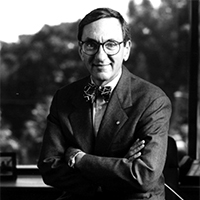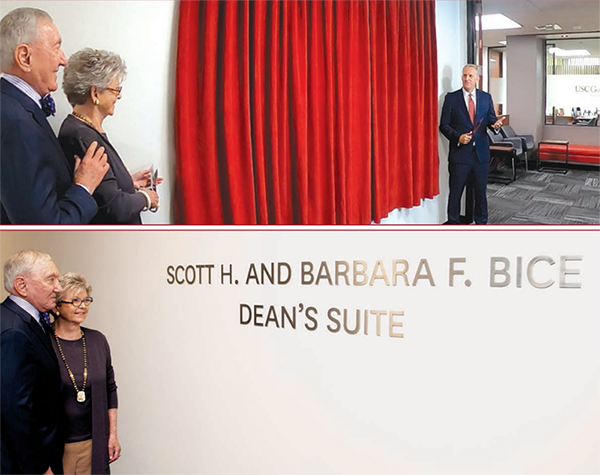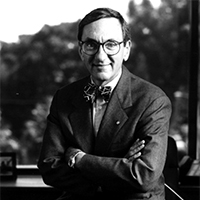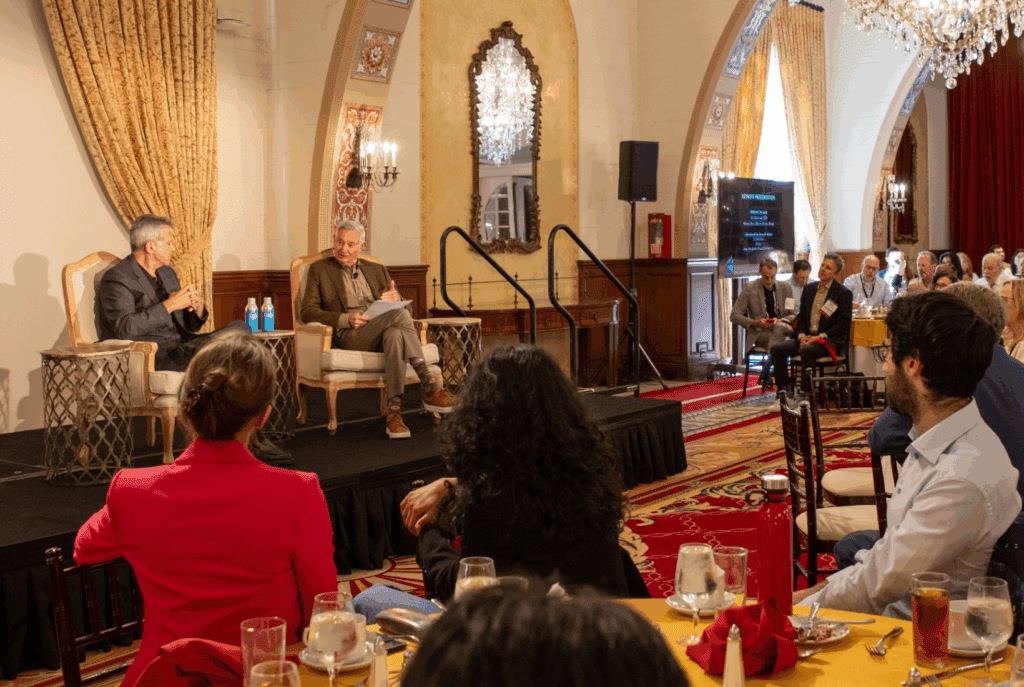Scott Bice (JD 1968) looks back on successful career as a professor, dean and philanthropist
 |
| Scott Bice |
Shortly after Scott Bice (JD 1968) and his wife Barbara were married and headed to Palm Springs for their honeymoon, Bice had news that added some excitement to the long drive.
“I said, ‘Oh, by the way, I think I will be a law teacher,”’ Bice says, sitting in the spacious backyard of his sunny Pasadena home, chuckling at the memory. As a clerk for Supreme Court Justice Earl Warren, Bice had already accepted a position with Gibson, Dunn and Crutcher, LLP. But a phone call from then-Dean Dorothy Nelson, now senior U.S. Circuit Judge of the U.S. Court of Appeals for the Ninth Circuit, asking Bice to join the faculty changed his plans.
His decision was the beginning of an unparalleled 52-year career of scholarship, teaching, leadership and philanthropy at the USC Gould School of Law, where Bice nurtured his love for teaching the law, and served as dean of the law school for 20 years.
Like many 1Ls, Scott Bice was first in his family to enroll in law school and didn’t know much about law. He certainly had no inclination that teaching law would be in his future. In his younger days, he had whetted his appetite for teaching at a Boy Scout camp on Catalina Island, where he taught youngsters how to swim. At Gould, his law classes, taught in the Socratic method, were exciting if stressful. His law professors noticed his enthusiasm and as a 3L, he was asked to teach a class.
“I enjoyed it, and the students reacted well,” he says. “By the time I left law school and became a law clerk, I was pretty convinced if I could find a law school teaching job, I would do that.” Fresh from law school, Bice embarked on the clerkship with Chief Justice Warren, who typically hired his clerks from three sectors of the nation (Bice was the West Coast hire). On arriving in D.C. one week after graduation, he learned he had a large office with an enormous judge’s chair and an assigned parking space.
“Pretty heady stuff,” he says. Then the cases — all of varying quality — started coming in.
“You had to read the petition, succinctly summarize it, give the justice a sense of the law on the case and recommend whether or not the court should take it,” Bice says. “My first day, I got five cases and went to work on them. At the end of the day I was asked ‘How are you doing?’ I was halfway through the first one.” He was told, “You’re going to have to do 10 to 15 a day to get through them all.” He found a rhythm, and the experience turned out to be good practice for grading papers.
Bice’s teaching style drew on the examples of numerous mentors and colleagues and reflected the changes in legal scholarship. He found great rewards from his classroom experiences.
“The joy comes when you put a challenging question to students, and they are trying but failing to answer it and are becoming more and more frustrated,” says Bice. “But they don’t stop trying; then somebody gets it right, and there’s this ‘ah-ha’ moment. The student levitates off the chair, and everyone else applauds. It is great fun.”
A crucial influence on his teaching was the change that law schools underwent in the mid1960s as multidisciplinary education began replacing teaching traditional “black letter” law. With older, more traditional faculty retiring, the stage was set for younger faculty from Yale Law School — including Martin Levine, Christopher Stone and George Lefcoe — to spur the momentum. Bice was free to pick and choose from both methods.
“Seeing the approaches of black letter teaching and interdisciplinary teaching side by side … one could see utility of both,” Bice says. “My teaching was an attempt to meld the two so that students learned what lawyers who practice in Superior Court need to know and also what lawyers who argue before the Supreme Court need to know about arguing whether something is constitutional or not.”
Bice also made it a point to obscure his personal politics from his teaching, especially about Constitutional Law and the Supreme Court. He saw it as his job to teach students to weigh the best arguments and think critically, not to choose sides — an easy trap to fall into considering how decisions from SCOTUS are often written as if the majority decision is overwhelmingly correct, he says. “A lot of law teachers may think it’s their job to show that ‘Justice A’ is a wonderful justice in 99 percent of cases, and ‘Justice B’ is a terrible judge and wrong in 99 percent of cases. Teach that way if you want — that’s not me. I focus on asking how would you argue for your client before ‘Justice A’ or ‘Justice B’?”

|
| Scott Bice reaped great rewards from his classroom experiences. |
He also found a sympathetic partner in Barbara, who was teaching AP English at San Marino High School when they married. They gained mutual appreciation of each other’s teaching loads and the pressure students were under to maintain their grades. When Bice assumed the law school deanship in 1980, it was, in his view, one of the best times at USC to be a dean. “Deans were like the presidents of small colleges with both responsibility for and authority to control admissions, the library, student affairs, academic affairs and fundraising,” he says.
“People say, ‘How could you stay 20 years as dean?’” Bice says. “We had that structure and support, and I had a terrific cadre of associate deans who I could tell, ‘Try to handle it, and if you can’t, come see me with a proposed solution,’ which they always did.”
As dean, Bice and his wife continued the legacy of the influential Judge Nelson, deepening relationships with alumni who brought substantial growth in philanthropic support: an increase in scholarships, a 65,000-square-foot addition to the law school building, and an impressive expansion of endowed chairs at USC Gould, from one to 25 — including the Virginia S. and Fred H. Bice Professor of Law, named for Bice’s parents, both USC alumni.
“Past USC Vice President and Chief Legal Officer Carl Franklin was a terrific partner to us as we took on the dean’s responsibility to raise philanthropic support,” Bice recalled. “I never forgot what he told me about the importance of making people feel valued.
One of his constant reminders was to express appreciation. Barbara and I truly found it a pleasure to work with philanthropically inclined people.”
The Bices also found satisfaction in their own philanthropy, with enthusiastic support of the Public Interest Law Foundation. One of their claims to Gould fame was their involvement in the annual PILF auction — which paid for summer internships for 1Ls — offering highly coveted trips to Catalina Island via their boat Deference over multiple years. Many students who enjoyed these trips remain friends.
Thanks to one of those boat trips, Bice became a bishop in the Universal Life Church after Matt Matzkin ( JD 2000) and Erin Gielow Matzkin ( JD 2002), who met on one of the Catalina jaunts, asked Bice to marry them. He has presided over about five weddings since.
As he transitions into retirement, Bice plans to continue his service on charitable boards and to spend more time in the Pacific Northwest and Canada, where Deference is moored. He also plans to support Barbara in her role as president-elect of the San Marino Rotary Club.
He leaves a legacy of learning, achievement and a flourishing, collegial law school community.
“I hope to be remembered as a good teacher, and as a dean who helped continue the traditions of the school: educational excellence, commitment to public service and mutual respect among faculty, staff, students and alumni,” he says.
 Colleagues, alumni and friends celebrated Professor and Dean Emeritus Scott Bice’s legacy and leadership in late October at the California Club.
Colleagues, alumni and friends celebrated Professor and Dean Emeritus Scott Bice’s legacy and leadership in late October at the California Club.
- Barbara and Scott Bice
- Scott Bice and Dean Andrew Guzman
- Dean Emeritus Dorothy Nelson and Barbara Bice
- Joseph Porter III (JD 1971) and Scott Bice
- From left: George Phillips, Jr. (JD 1991), Dina Phillips, Eva Iino, John Iino (JD 1987)
- Professor Scott Altman
- Erin Gielow Matzkin (JD 2002) and Matt Matzkin (JD 2000).
- Karen Wong (JD 1986) and Ruth Lavine (LLB 1943)
- From left: Steven Atlee (JD 1999) and Tamerlin Godley (JD 1996)
- From left: USC Gould Board of Councilors Chair Tom Larkins (JD 1986) and
- Gould Board of Councilors Clerkship Committee Chair Dave Walsh (JD 1985)
Dean’s suite named in honor of Scott and Barbara Bice

In recognition of Professor and Dean Emeritus Scott Bice’s lifetime of leadership, mentorship and service, and with deep gratitude for his and Barbara’s generosity to the Law School, the Dean’s Suite was renamed in their honor.
“Scott and Barbara stand as examples to all alumni of what it means to be involved in the life of the law school, to give back and shape it for the better,” said Dean Andrew Guzman.


 Colleagues, alumni and friends celebrated Professor and Dean Emeritus Scott Bice’s legacy and leadership in late October at the California Club.
Colleagues, alumni and friends celebrated Professor and Dean Emeritus Scott Bice’s legacy and leadership in late October at the California Club. In recognition of Professor and Dean Emeritus Scott Bice’s lifetime of leadership, mentorship and service, and with deep gratitude for his and Barbara’s generosity to the Law School, the Dean’s Suite was renamed in their honor.
In recognition of Professor and Dean Emeritus Scott Bice’s lifetime of leadership, mentorship and service, and with deep gratitude for his and Barbara’s generosity to the Law School, the Dean’s Suite was renamed in their honor.
















